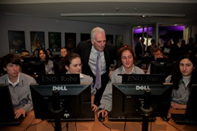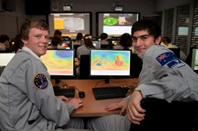Robotic Mission to Mars Launched at Victorian Space Science Education Centre (VSSEC)

On the 21st July, Education Minister, Martin Dixon, officially launched VSSEC's Robotic Mission to Mars program. This web-based program will allow students anywhere in the world to control a real rover on a simulated Mars surface from their school. The web-based software turns any school computer lab into Mission Control. From there students can control the rover, analyse rock, soil and atmospheric samples and collect data for further analysis.
The VSSEC Mars Autonomous Science Laboratory (MASL) touched down on the VSSEC Mars surface on the 35th Anniversary of Viking 1 landing on Mars and the 42nd Anniversary of the first man walking on the moon. The VSSEC Robotic Mission to Mars program maximises the effectiveness of web-based learning by applying the research-based strategies for effective teaching and learning to an on-line scenario program. Learning opportunities such as this help engage students in Science, Technology, Engineering and Mathematics, and build the skilled workforce needed to tackle future challenges.



This project was made possible thanks to the expertise of VSSEC's university and industry partners.
- Students from the Australian Centre for Field Robotics at The University of Sydney designed and built the rover under the direction of Dr Ali Goktogan;
– Students from the ACRI Games Technology Lab at La Trobe University designed the student interface under the supervision of Dr John Rankin;
– Students from Monash School of Geoscience designed and built the robotic arm under the supervision of Ms Marion Anderson. Marion also contributed her extensive knowledge of Mars geology and the experience she gained working on the site selection of the NASA rovers Spirit, Opportunity and Curiosity;
– Aerion Technologies made it possible for students to access the Mission Control software via the internet and developed control software that allows students to drive the rover via the Mission Control software;
– The Pod produced the movie showing the launch of the rover and its landing on Mars
– VSSEC produced the pre-mission curriculum material and web-based Mars Site Selection Research Project
By integrating this project within the undergraduate and postgraduate courses at The University of Sydney, La Trobe and Monash University, VSSEC has provided industry experience for university students and highlighted study paths for students interested in science, engineering and computer science. At the launch representatives from each of the universities discussed their involvement in the project and the impact it had on their students.
The launch also coincided with the announcement of the landing site chosen for NASA's next Mars rover, Curiosity. During the preparation for their Robotic Mission to Mars, students will complete an on-line Mars Site Selection Research Project. Using data and maps provided by NASA, students will analyse the same four potential landing sites selected by the world's scientists and engineers: Gale, Holden, Eberswalde and Mawrth. During her speech, Marion Anderson from Monash University, who has been involved in the site selection process for Curiosity, commented that it had taken the world's scientists more than two years to make a decision. She then wondered if the students would come to the same conclusion as the researchers (and if they could do it faster).
Visit www.vssec.vic.edu.au for more information about this program.